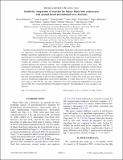Sensitivity comparison of searches for binary black hole coalescences with ground-based gravitational-wave detectors
Author(s)
Mohapatra, Satya; Cadonati, Laura; Caudill, S.; Clark, James; Hanna, C.; Klimenko, Sergey; Pankow, Chris; Vaulin, Ruslan; Vedovato, Gabriele; Vitale, Salvatore; ... Show more Show less
DownloadPhysRevD.90.022001.pdf (7.235Mb)
PUBLISHER_POLICY
Publisher Policy
Article is made available in accordance with the publisher's policy and may be subject to US copyright law. Please refer to the publisher's site for terms of use.
Terms of use
Metadata
Show full item recordAbstract
Searches for gravitational-wave transients from binary black hole coalescences typically rely on one of two approaches: matched filtering with templates and morphology-independent excess power searches. Multiple algorithmic implementations in the analysis of data from the first generation of ground-based gravitational-wave interferometers have used different strategies for the suppression of non-Gaussian noise transients and have targeted different regions of the binary black hole parameter space. In this paper we compare the sensitivity of three such algorithms: matched filtering with full coalescence templates, matched filtering with ringdown templates, and a morphology-independent excess power search. The comparison is performed at a fixed false alarm rate and relies on Monte Carlo simulations of binary black hole coalescences for spinning, nonprecessing systems with a total mass of 25–350 M[subscript ⊙], which covers a portion of the parameter space of stellar mass and intermediate mass black hole binaries. We find that in the mass range of 25–100 M[subscript ⊙], the sensitive distance of the search, marginalized over source parameters, is the best with matched filtering to full waveform templates, which is within 10% of the next most sensitive search of morphology-independent excess power algorithm, at a false alarm rate of 3 events/year. In the mass range of 100–350 M[subscript ⊙], the same comparison favors the morphology-independent excess power search within 20% of matched filtering with ringdown templates. The dependence on mass and spin is also explored.
Date issued
2014-07Department
MIT Kavli Institute for Astrophysics and Space ResearchJournal
Physical Review D
Publisher
American Physical Society
Citation
Mohapatra, Satya, Laura Cadonati, Sarah Caudill, James Clark, Chad Hanna, Sergey Klimenko, Chris Pankow, Ruslan Vaulin, Gabriele Vedovato, and Salvatore Vitale. “Sensitivity Comparison of Searches for Binary Black Hole Coalescences with Ground-Based Gravitational-Wave Detectors.” Phys. Rev. D 90, no. 2 (July 2014). © 2014 American Physical Society
Version: Final published version
ISSN
1550-7998
1550-2368